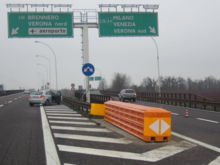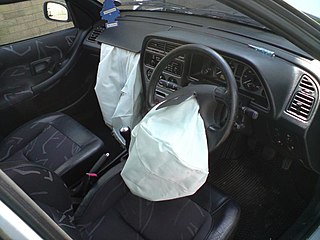
An airbag is a vehicle occupant-restraint system using a bag designed to inflate exceptionally quickly and then deflate during a collision. It consists of an airbag cushion, a flexible fabric bag, an inflation module, and an impact sensor. The purpose of the airbag is to provide a vehicle occupant with soft cushioning and restraint during a collision. It can reduce injuries between the flailing occupant and the vehicle's interior.

Crumple zones, crush zones, or crash zones are a structural safety feature used in vehicles, mainly in automobiles, to increase the time over which a change in velocity occurs from the impact during a collision by a controlled deformation; in recent years, it is also incorporated into trains and railcars.

A crash test is a form of destructive testing usually performed in order to ensure safe design standards in crashworthiness and crash compatibility for various modes of transportation or related systems and components.

A rear-end collision, often called rear-ending or, in the UK, a shunt, occurs when a forward-moving vehicle crashes into the back of another vehicle in front of it. Similarly, rear-end rail collisions occur when a train runs into the end of a preceding train on the same track. Common factors contributing to rear-end collisions include driver inattention or distraction, tailgating, panic stops, brake checking and reduced traction due to wet weather or worn pavement.

Road traffic safety refers to the methods and measures used to prevent road users from being killed or seriously injured. Typical road users include pedestrians, cyclists, motorists, vehicle passengers, and passengers of on-road public transport.

Crash incompatibility, crash compatibility, vehicle incompatibility, and vehicle compatibility are terms in the automobile crash testing industry. They refer to the tendency of some vehicles to inflict more damage on another vehicle in two-car crashes. Vehicle incompatibility is said to lead to more dangerous, fatal crashes, while compatibility can prevent injury in otherwise comparable crashes.

A bumper is a structure attached to or integrated with the front and rear ends of a motor vehicle, to absorb impact in a minor collision, ideally minimizing repair costs. Stiff metal bumpers appeared on automobiles as early as 1904 that had a mainly ornamental function. Numerous developments, improvements in materials and technologies, as well as greater focus on functionality for protecting vehicle components and improving safety have changed bumpers over the years. Bumpers ideally minimize height mismatches between vehicles and protect pedestrians from injury. Regulatory measures have been enacted to reduce vehicle repair costs and, more recently, impact on pedestrians.

The European New Car Assessment Programme is a European voluntary car safety performance assessment programme based in Leuven, Belgium. Formed in 1996, the first results were released in February 1997. It was originally started by the Transport Research Laboratory for the UK Department for Transport but later backed by several European governments, as well as by the European Union (EU). Their slogan is "For Safer Cars".

A Jersey barrier, Jersey wall, or Jersey bump is a modular concrete or plastic barrier employed to separate lanes of traffic. It is designed to minimize vehicle damage in cases of incidental contact while still preventing vehicle crossovers resulting in a likely head-on collision. Jersey barriers are also used to reroute traffic and protect pedestrians and workers during highway construction. They are named after the U.S. state of New Jersey which first started using the barriers as separators between lanes of a highway in the 1950s.

A buffer stop, bumper, bumping post, bumper block or stopblock (US), is a device to prevent railway vehicles from going past the end of a physical section of track.

The Steel And Foam Energy Reduction Barrier, sometimes generically referred to as a soft wall, is a technology found on oval automobile race tracks and high speed sections of road and street tracks, intended to absorb and reduce kinetic energy during the impact of a high speed crash, and thus, lessen injuries sustained to drivers and spectators. It was designed by a team of engineers at the Midwest Roadside Safety Facility at the University of Nebraska-Lincoln. It was developed from 1998–2002, and first installed at the Indianapolis Motor Speedway in May 2002.

A side collision is a vehicle crash where the side of one or more vehicles is impacted. These crashes typically occur at intersections, in parking lots, and when two vehicles pass on a multi-lane roadway.

In mechanics, an impact is when two bodies collide. During this collision, both bodies decelerate. The deceleration causes a high force or shock, applied over a short time period. A high force, over a short duration, usually causes more damage to both bodies than a lower force applied over a proportionally longer duration.

The Mercedes-Benz "Ponton" series are a range of sedans / saloon car models from Daimler-Benz, introduced starting in 1953, and subsequently nicknamed 'Ponton', referring to its ponton styling, a prominent styling trend that unified the previously articulated hood, body, fenders and runnings boards into a singular, often slab-sided envelope. At the time, Mercedes itself did not refer to any of its cars using the nickname.

Béla Barényi was an ethnic Hungarian engineer from Austria-Hungary, who was a prolific inventor, sometimes even compared to Thomas Edison. Barényi made numerous crash protection inventions, and is therefore regarded as the father of passive safety in automotive design.
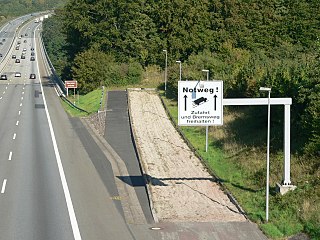
A runaway truck ramp, runaway truck lane, escape lane, safety ramp, emergency escape ramp, or truck arrester bed is a traffic device that enables vehicles which are having braking problems to stop safely. It is typically a long, sand- or gravel-filled lane connected to a steep downhill grade section of a main road, and is designed to accommodate large trucks or buses. It allows a moving vehicle's kinetic energy to be dissipated gradually in a controlled and relatively harmless way, helping the operator stop it safely.
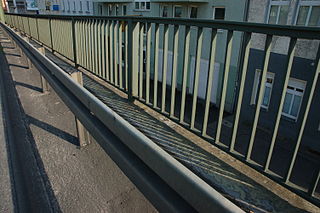
Traffic barriers keep vehicles within their roadway and prevent them from colliding with dangerous obstacles such as boulders, sign supports, trees, bridge abutments, buildings, walls, and large storm drains, or from traversing steep (non-recoverable) slopes or entering deep water. They are also installed within medians of divided highways to prevent errant vehicles from entering the opposing carriageway of traffic and help to reduce head-on collisions. Some of these barriers, designed to be struck from either side, are called median barriers. Traffic barriers can also be used to protect vulnerable areas like school yards, pedestrian zones, and fuel tanks from errant vehicles.
Energy absorber may refer to:

A cable barrier, sometimes referred to as guard cable or wire rope safety barrier (WRSB), is a type of roadside or median safety traffic barrier/guard rail. It consists of steel wire ropes mounted on weak posts. As is the case with any roadside barrier, its primary purpose is to prevent a vehicle from leaving the traveled way and striking a fixed object or terrain feature that is less forgiving than itself. Also similar to most roadside barriers, cable barriers function by capturing and/or redirecting the errant vehicle.
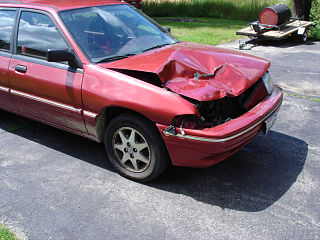
Road traffic collisions generally fall into one of five common types:
